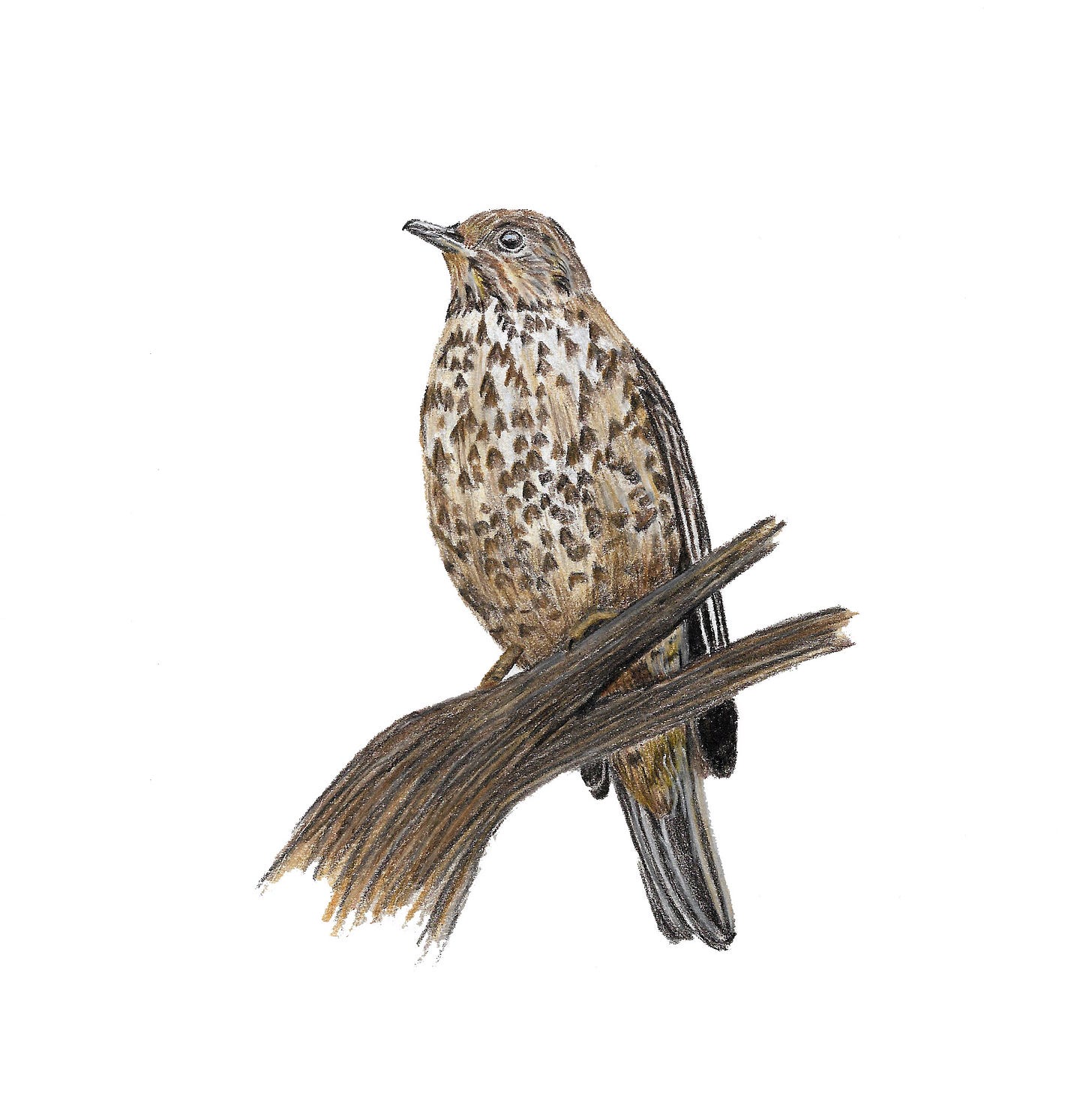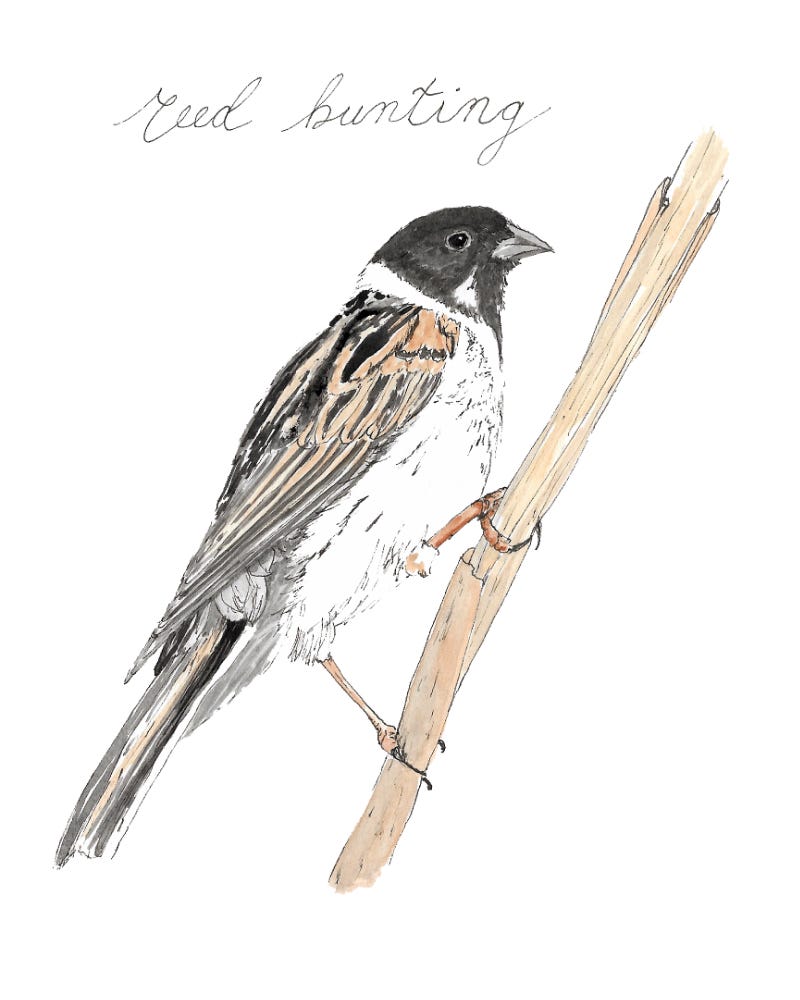February Nature Diary (2025)
Lighter days, some occasional sunshine, Spring flowers, bird song and a short intro to the Alder tree
1st February
After a very miserable January, the sun was shining today and so we took a family trip up to the Ford & Etal estate to see the snowdrops around Etal Castle. They weren’t quite at their peak yet, although they definitely fitted the description of ‘carpet’!
As the weather was so lovely, we then went on one of the many circular walks on the Estate and actually ended up shedding some layers as the sunshine was surprisingly warm once we were out of the wind. We didn’t pass a single other person the whole time we were walking - but we did see a lot of buzzards lazily circling above the fields, as well as three roe deer, who ran over a field and across our path (much to the excitement of our Border Terrier, who was very unimpressed that he was not allowed to give chase!)


Every month I curate a nature diary-style collection of my illustrations and observations of things I’ve noticed and been inspired by in my local environment. Make sure you never miss a post by subscribing to Drawn to Nature for free; and if you are minded to support my work, I’d be grateful if you would consider becoming a paid subscriber.
10th February
I noticed some new catkins appearing on some trees that I pass on one of my regular dog walks, alongside some of the winter’s cones. I was inspired both to do a quick sketch but also to identify the tree as an Alder.
According to The Woodland Trust Alder trees are monoecious, meaning that both male and female flowers can be found on the same tree and what I took to be cones are actually last season's pollinated female catkins. New green female catkins will appear soon, to accompany the long yellow make ones.
Alder is a European native and is usually found in moist ground near rivers, ponds and lakes, where its roots can help prevent soil erosion as well as fix nitrogen to improve soil fertility and condition. They can also grow in drier locations, in mixed woodland and on forest edges, which is the habitat of my local trees.
The green dye from the flowers of Alder used to be used to colour and camouflage the clothes or outlaws like Robin Hood and traditionally the wood was used for charcoal and gunpowder.
13th February
The internet (and particularly Substack) seems to have gone mad for snowdrops this year, but we shouldn’t forget the joy that is brought by some of the other early flowering bulbs. I noticed these multi-coloured crocus spears thrusting upwards in our local cemetery today, alongside some winter aconite and the odd primrose.
Have you ever noticed how the flowers of late winter/early spring seem to be predominantly white (snowdrops), yellow (winter aconite, celandine, primroses, cowslips and daffodils) purple (bluebells, squill, dog violets) or all three (crocuses, hellebore)?!
Do you know your aconite from your hellebore? The Woodland Trust have got a great early Spring wildflower quiz - can you beat my 11/12 score?!
18th February
I’ve heard a song thrush out on my walks a couple of times in the last week, but today is the first time I’ve seen one back in our garden.
If you’ve spotted frogspawn, heard a song thrush or seen blackthorn flowering already this year, I’d encourage you to record it via The Woodland Trust’s Nature’s Calendar portal that compiles essential data to track how different species are affected by climate change and weather. I logged my Song Thrush sighting and I’m looking forward to getting the ‘Signs of Spring’ report sometime in March that is produced after the data have been aggregated and studied!
This illustration of a Song Thrush in coloured pencil is available as one of my square note cards; sets of x4 cards, printed in the UK onto recycled card stock and complete with a brown kraft envelope for £12.
22nd February
Milder weather and some sunshine seem to have brought out all of the birds this morning - the air was busy with the sound of their calls back-and-forth and our path was constantly crossed by birds darting between areas of cover. The route we took crosses some heathland, where I heard skylark for the first time this year and my first ever reed bunting.
We ended with a loop through our local cemetery, which was alive with goldfinch, chaffinch, song thrush, rooks and crows, starlings, wood pigeons, robins, blackbirds, dunnock and house sparrows as well as blue tits and great tits!
Birds I’ve seen/heard this month
I finally downloaded the Merlin Bird ID app to my phone after having had it recommended to me by many different people. I don’t consider myself a hardcore bird watcher - not least because there are so many birds that I can’t recognise by sight, let alone song - but this app may well be setting my feet on the path to being significantly more informed.
Merlin Bird ID was developed by the Cornell Lab of Ornithology at Cornell University. The absolute best feature is to be able to use your phone to record bird sounds when you're out in nature and being told in real-time what bird it belongs to. I've found it really useful to simply have the app recording as I walk through a space with lots of bird song so that I can start to become more familiar with the common calls and sounds. I can reliably identify a wren, a robin, a great tit and a blue tit after four weeks of doing this activity and hopefully I'll be able to recognise more as the year goes on.
Birds I’ve heard (or seen and recognised) this month include:
European Robin
Eurasian Blue Tit
Carrion Crow
Great Tit
European Goldfinch
Common Chaffinch
House Sparrow
Eurasian Magpie
Dunnock
Eurasian Jackdaw
Eurasian Wren
European Greenfinch
European Starling
European Blackcap
Rook
Long-tailed Tit
Song Thrush
Black-headed Gull
Common Redshank
Eurasian Curlew
Herring Gull
Eurasian Skylark
Reed Bunting
Oyster Catcher
Blackbird
Phew! Congratulations if you made it to the bottom of that list! I don’t think I’ll include all of my bird identifications every month, but I might share some of the more ‘unusual’ birds I come across.









Lovely work 😍
The earth is coming back to life! Thanks Ali :0)